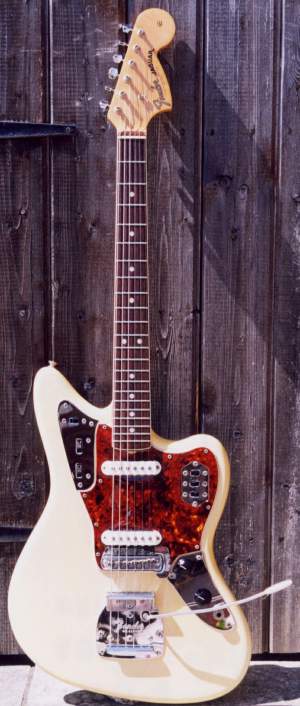
The Fender company having achieved massive success throughout the 'fifties with sales of their Telecaster, Esquire, Stratocaster and Precision bass guitars, by the end of the decade had expanded the line further with a couple of budget models and a new solid-body, the Jazzmaster. The Jazzmaster (which was anything but) introduced a new body design and "floating" tremolo system and bridge, and its neck pick-up could be routed via a secondary circuit on the upper left-hand side of the body, lending it a muffled, "jazzy" tone. This was not enough to disguise its basic Fender characteristics, however, and the new instrument failed to find any support among the jazz fraternity; instead, it became - and remains - the surf-punk's ideal guitar.
In 1962, the company launched its new, top-of-the-range Jaguar. Basically a fancier version of the Jazzmaster, it featured a shorter scale, an extra fret, and smaller pick-ups mounted in chrome-plated notched cradles with individual on/off switches and a tone switch. The volume and tone controls were mounted on chromium plates, and, being the gimmick-crazy 'sixties, the guitar was supplied with a novel spring-activated flip-up string mute in front of the bridge. As a response to complaints concerning the poor grounding of the Jazzmaster's electronics, Fender hard-wired the pick-up circuit of the Jaguar into a copper bath that covered the entire internal control rout. Little wonder then, that the guitar was launched at a hefty retail of $379 for the basic model.
Which wouldn't have been so bad had the guitar actually performed well. It didn't; the Jaguar's problems lay, like the Jazzmaster before it, in that cockamamy tremolo system. Fender had sunk the money into curing the lesser of its evils, when what was needed was a way of anchoring the strings more efficiently. As it was, the strings passed over the "floating" bridge at a very shallow angle, the lower string often becoming detached from its saddle. The bridge itself rattled like a freight train, and as for that mute... well, it was a nice try.
Why did I buy it, then? As a Beach Boys fan, I needed that authentic surf sound, just like Carl Wilson had on all those early hits. The guitar is in virtually mint condition, and it's perhaps not surprising that it hasn't been played much. However, you'll notice, dear reader, an extra piece of hardware located in front of the tremolo plate. This is the Whizzo Buzz Stop, a simple yet effective device that I heartily recommend to all you Jazzer'n'Jag fanatics out there, if you're interested in hearing your guitar perform like a proper one. It's a metal roller under which the strings pass, dragging them down across the bridge at an acute angle, thus pinning the bridge to the body and stopping it rattling. Tone and sustain are much improved, and tuning problems reduced. No drilling is required, and it can be removed at any time, so go get one today!
Recording debut: Poor Skeleton Steps Out (BBC version, played by Andy P), XTC March 1989.
Features on:
Robinson Crusoe (solo, Mike Dunphy - we actually used the
damn mute!) + Not Exactly D.L.E.R.C. (Cud, 1990);
Sweet Dollar Bill (Louis Philippe, 1996);
Black River Falls (Cathal Coughlan, 1999);